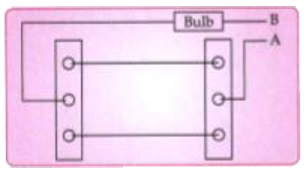Which one lives in burrows?
Tubifex
Chaetoperis
Terebella
Both B and C
The correct Answer is:D
To determine which organism lives in burrows among the given options (Tubifex, Ketoperis, Terabella, both B and C), we can analyze each option step by step.
Step 1: Analyze Tubifex
- Description: Tubifex worms are known to inhabit sediments of lakes and rivers and are often used as live food for fish.
- Habitat: They are cosmopolitan and typically found in sediments rather than burrowing into them.
- Conclusion: Tubifex does not primarily live in burrows.
Hint: Consider the habitat preferences of Tubifex and whether they indicate burrowing behavior.
Step 2: Analyze Ketoperis
- Description: Ketoperis, also known as parchment worms, belong to the class Polychaeta and are segmented worms.
- Habitat: They are often found in shallow, silty waters, attached to solid substrates like rocks and coral. They can also be partially buried in sediments.
- Conclusion: Ketoperis exhibits burrowing behavior.
Hint: Look for organisms that are described as being partially buried or attached to substrates in a way that indicates burrowing.
Step 3: Analyze Terabella
- Description: Terabella is a marine, burrowing, and sedentary annelid.
- Habitat: These worms grow in tubes made of sand, indicating they live in burrows.
- Conclusion: Terabella also exhibits burrowing behavior.
Hint: Identify whether the organism constructs tubes or burrows as part of its lifestyle.
Step 4: Combine Findings
- From the analysis, we found that:
- Tubifex does not live in burrows.
- Ketoperis does exhibit burrowing behavior.
- Terabella also exhibits burrowing behavior.
Given that both Ketoperis and Terabella live in burrows, the correct answer is both B and C.
Final Answer:
The organisms that live in burrows are Ketoperis and Terabella (both B and C).
---
- Description: Tubifex worms are known to inhabit sediments of lakes and rivers and are often used as live food for fish.
- Habitat: They are cosmopolitan and typically found in sediments rather than burrowing into them.
- Conclusion: Tubifex does not primarily live in burrows.
- Description: Ketoperis, also known as parchment worms, belong to the class Polychaeta and are segmented worms.
- Habitat: They are often found in shallow, silty waters, attached to solid substrates like rocks and coral. They can also be partially buried in sediments.
- Conclusion: Ketoperis exhibits burrowing behavior.
- Description: Terabella is a marine, burrowing, and sedentary annelid.
- Habitat: These worms grow in tubes made of sand, indicating they live in burrows.
- Conclusion: Terabella also exhibits burrowing behavior.
- From the analysis, we found that:
- Tubifex does not live in burrows.
- Ketoperis does exhibit burrowing behavior.
- Terabella also exhibits burrowing behavior.
Given that both Ketoperis and Terabella live in burrows, the correct answer is both B and C.
The organisms that live in burrows are Ketoperis and Terabella (both B and C).
Topper's Solved these Questions
- PHYLUM - ANNELIDABOOK - DINESH PUBLICATION ENGLISHCHAPTER - PHYLUM - ANNELIDAEXERCISE - Revision Question From Compretitive Exams.
38 Videos
- PHYLUM - ANNELIDABOOK - DINESH PUBLICATION ENGLISHCHAPTER - PHYLUM - ANNELIDAEXERCISE - Check your grasp
10 Videos
- PHOTOSYNTHESISBOOK - DINESH PUBLICATION ENGLISHCHAPTER - PHOTOSYNTHESISEXERCISE - CYG
10 Videos
- PHYLUM - ARTHROPODABOOK - DINESH PUBLICATION ENGLISHCHAPTER - PHYLUM - ARTHROPODAEXERCISE - CYG
20 Videos
Similar Questions
Which one is a burrowing marsupial ?
View SolutionWhich one is a living fossil ?
View SolutionTwo green plants are kept separately in oxygen free containers, one in the dark and the other in continuous light . Which one will live longer ?
View SolutionWhich one is non-living cell inclusion ?
View SolutionWhich one is used for measuring osmotic potential of living cells ?
View SolutionThe diagram below shows a dual control switch circuit connected to a bulb.

Out of A and B which one is the live wire and which one is the neutral wire ?
View SolutionWhich has living cells
View SolutionWhich one of the following is not a living fossil?
View SolutionWhich one of the following is a living fossil ?
View SolutionWhich one of the following is not a living fossil?
View Solution
